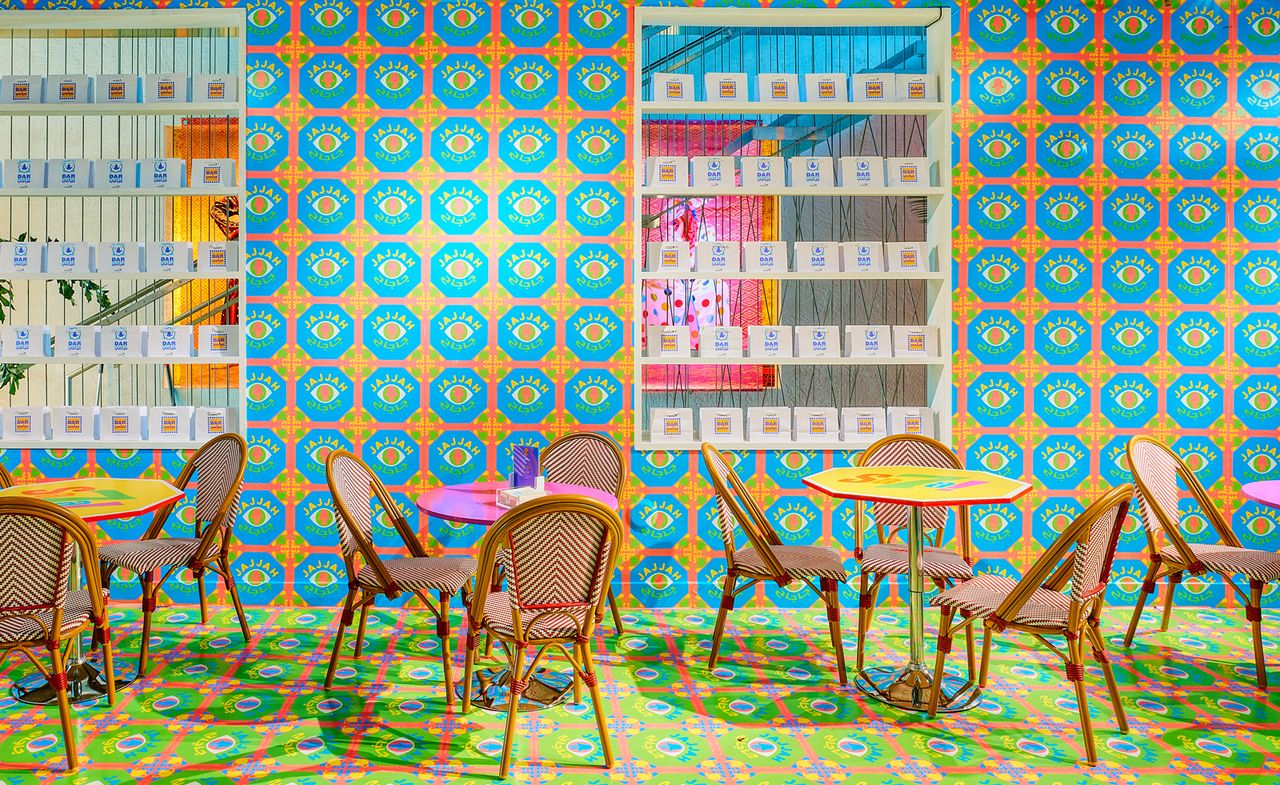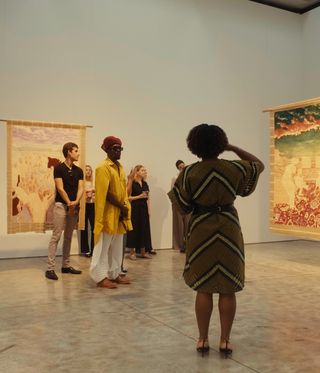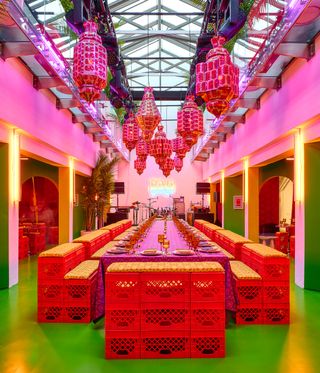What are art clubs? Inside the heady world of groups offering exclusive access to the industry
Private clubs and museum patron groups offer insider knowledge and the chance for deeper art world engagement

'The demand for access to the art world is clear; it’s one thing to walk into a commercial gallery, but it’s another to go behind-the-scenes with an artist or curator and hear the story behind the work,' Marlies Verhoeven tells Wallpaper*. Verhoeven is co-founder and CEO of The Cultivist, a hybrid art club and concierge service she launched with Daisy Peat in 2015. Originally created to streamline admission to cultural institutions, The Cultivist has grown to become a global leader in creative collaborations and events.
Now, in addition to admission to places like museums, the club organises nearly 200 events annually comprising panels, private collection tours, art-centric trips around the world and experiences in partnership with artists. Its membership is tiered starting at $440 annually up to $15,000 at an invitation-only level. The perks increase depending on the level, with added benefits like a personal concierge to arrange cultural itineraries.
The Cultivist is one of very few private art clubs, but the idea has a long history. For over a century, museums worldwide have maintained groups that offer members a way to engage on a more meaningful level. Museum groups afford members with different benefits like invitations to events and free admission. Fees vary depending on the institution and can range from several hundred dollars per year to several thousand, a portion of which is typically tax deductible. Many museums have advanced levels where members support funding of and make decisions on programming and acquisitions.
For the museums, these groups provide several benefits. In addition to fundraising, collectors groups help institutions maintain engagement with future generations of visitors and donors. The Guggenheim’s Young Collectors Council (YCC), for example, brings together young patrons (ages 21 to 40) who gain access to things like studio visits, curator-led tours and events, including its popular annual YCC Party. The group, which is $1,750 to join, also supports the museum’s growing collection.

Club Rococo holds monthly events, featured here is Nengi Omuku giving a walkthrough of her show at Kasmin
'Members don’t just passively engage—they actively vote on proposed acquisitions,' says Ayesha Fardell, the museum’s manager of individual giving. 'This unique opportunity allows young collectors to learn directly from curators [and] to participate in a thoughtful and impactful way.' Since its founding in 1996, the YCC has helped the Guggenheim acquire over 180 works.
For patrons, museum groups provide perks beyond those listed in their membership. Some are professionals from outside the art industry interested in adding culture to their daily lives. Others might be drawn to the social aspect. 'Maybe it’s a post-Covid thing, but people are really longing for in-person experiences and community,' says Dillon Lawson-Johnston, who has been a member of the YCC for several years, along with his brother Sam. As great-great-grandsons of the museum’s founder and namesake, Solomon R. Guggenheim, the brothers grew up in and around the institution and have family members on the board.
'The barrier between the YCC and the museum staff and board is pretty thin and they genuinely want to know what the next generation looks for in a museum,” says Sam. 'YCC members have access to people like curators on a deep level that isn’t common for museum groups, which makes it really meaningful to join.'
Wallpaper* Newsletter
Receive our daily digest of inspiration, escapism and design stories from around the world direct to your inbox.
Members bring their own interests and engagement level. Some might offer their expertise on planning the YCC Party while others bring insight into acquisitions. How much or how little members participate is up to them, but ultimately, the YCC offers patrons a way to take their support of the museum beyond the financial. 'It’s not just about donating and walking away,' Dillon says. 'It’s about forming a relationship with the museum and its legacy.”
With The Cultivist, however, members are not tied to an institution. Indeed, many are already deeply involved with the art world and use the club for the social and educational aspects, as well as its global network. 'Most of our members travel constantly and are involved in the arts in their communities, whether as art lovers, donors or museum board members, but they want the same level of access globally that they experience locally,' Verhoeven says. 'They can certainly use their own network to get a sold-out museum ticket, but it makes it a lot easier if we do it for them.”

The DAR MIAMI 1446 dinner at Art Basel Miami Beach
As The Cultivist scaled globally, the team began collaborating with brands on member experiences, such as pop-up exhibitions. 'These partnerships help us take our relationships with artists to a level we wouldn’t otherwise be able to afford,' Verhoeven says. 'We might start by bringing our members to meet an artist in their studio, then we’ll see them in a museum show years later, then with corporate sponsorship we can organise an experience that brings the artist’s vision to life in an innovative setting.'
As part of a multi-year partnership, The Cultivist recently collaborated with Capital One on a pop-up experience with Moroccan photographer Hassan Hajjaj during Art Basel Miami Beach in December. Called 'DAR MIAMI 1446,' the exhibition resembled a vibrant souk with visitors able to try teas and purchase exclusive merchandise by Hajjaj during the day. At night, MICHELIN-starred restaurateur Rose Previte curated a series of Middle Eastern-inspired dinners for Capital One cardholders, followed by musical performances. 'I could easily have set up a table and put my artwork on it, but this project was bigger than me,' Hajjaj tells Wallpaper*. 'It was about bringing Moroccan culture to Miami Beach, about Rose and her amazing food, about the musicians. The Cultivist and Capital One gave me complete freedom. It was a beautiful project.'
This May, The Cultivist and Capital One are taking their relationship with Hajjaj further by organising a trip to Morocco with a curated itinerary of cultural experiences, including a visit to Hajjaj’s studio, as well as those of local artists. 'I’m very excited the artists in the area will have a chance to show off their art and meet collectors and curators–whoever is visiting,' says Hajjaj.
The interest in direct engagement with artists seems to be widespread. 'I didn’t fall in love with the art world until I became involved on a deeper level–visiting artist studios and hearing about their practice,' says art adviser Maria Vogel. Vogel organises gallery and studio visits as part of her advisory, but realised there was broader interest in these events. In April 2024, she launched Club Rococo where members pay $40 per month for access to programming like visits to studios, galleries and private collections, as well as discounts to cultural institutions and brands and a newsletter with industry insights. While centred on New York, Vogel plans to expand the club to other cities in the future. Club Rococo members are a mix of art collectors and enthusiasts hoping to learn more, but not necessarily involved with the industry or interested in buying. 'The club tends towards enthusiast level,' Vogel says. “They might aspire to collect some day, but the members who benefit most are those that don’t have the ability to access the industry like a seasoned collector might.”
For the artists who collaborate with groups like Club Rococo, these experiences put them on buyers’ radars and help them establish a network that might lead to future projects with curators and dealers.
'Art clubs play a vital role in creating community and connection and facilitating educational and fun experiences,' says artist Hiba Schahbaz. Along with four other artists, Schahbaz participated in a dinner Vogel organised with collectors, curators, writers and art enthusiasts. 'It was a thoughtful event where each dish was inspired by the artists being honoured and a lovely community moment,' Schahbaz explains. 'Being an artist can be a solitary profession, and sharing space with a vibrant group of people who love art is very nourishing for the spirit.'
Annabel Keenan is a Brooklyn-based writer specialising in contemporary art, market reporting, and sustainability. She contributes to several publications, including The New York Times, The Financial Times, The Art Newspaper, Artforum, and Brooklyn Rail. She is also the author of Climate Action in the Art World: Towards a Greener Future, a call for sustainable practices in the art world (May 2025, Lund Humphries and Sotheby’s Institute).
-
 Lexus makes its mark on Milan Design Week 2025 with four new interactive installations
Lexus makes its mark on Milan Design Week 2025 with four new interactive installationsLexus’ annual installation at Milan Design Week focuses on human-centred technology and the role of data and design in shaping the luxury car of the future
By Jonathan Bell Published
-
 First look: Ikea’s new Stockholm collection is a venture into affordable luxury
First look: Ikea’s new Stockholm collection is a venture into affordable luxuryAt Milan Design Week, we meet with Ikea designer Paulin Machado to hear about the inspiration behind the new collection and to discuss the future of design in a disconnected world
By Tianna Williams Published
-
 Is Kiyoshi Kurosawa's 'Cloud' the techno thriller for the decade of online desperation?
Is Kiyoshi Kurosawa's 'Cloud' the techno thriller for the decade of online desperation?Japanese director Kiyoshi Kurosawa dives into the black market world of merchandising in his latest techno thriller
By Billie Walker Published